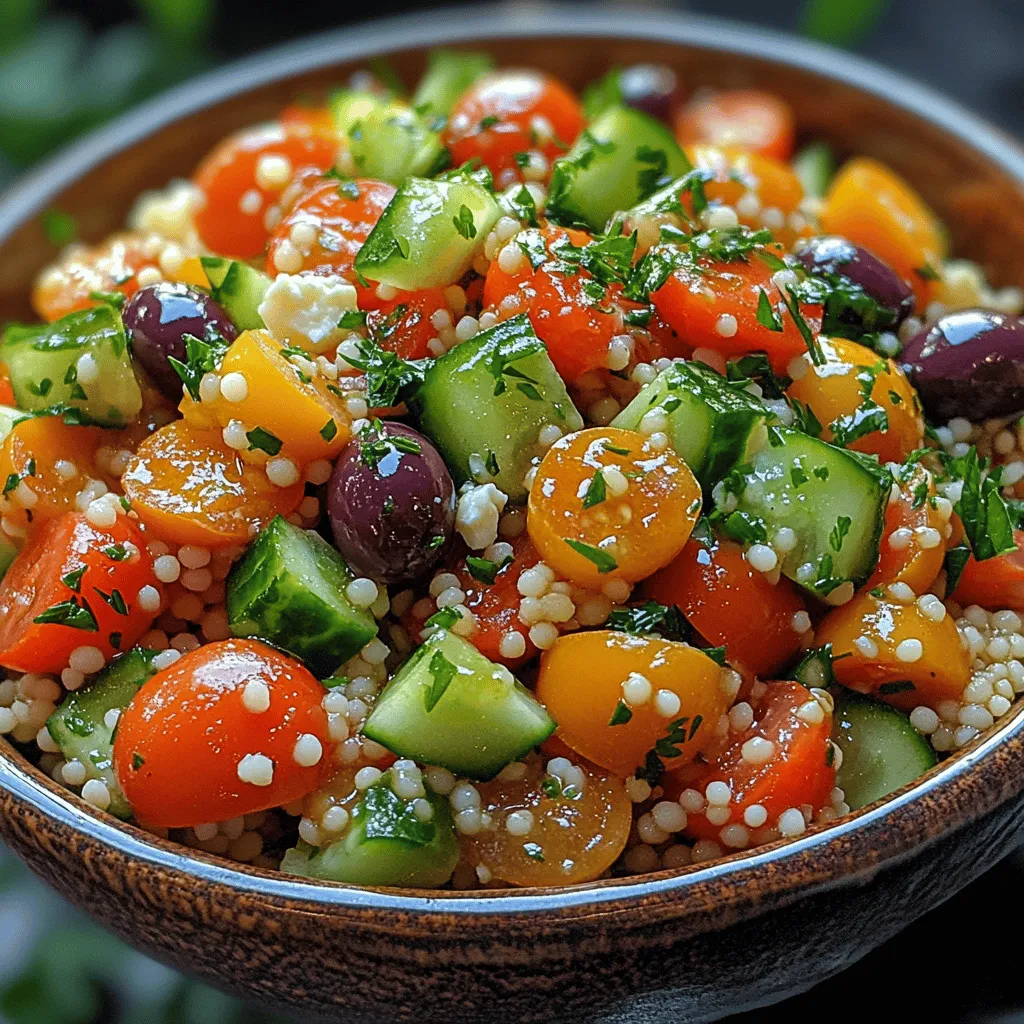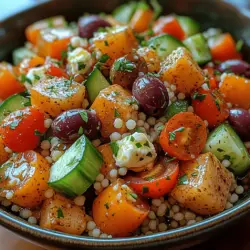Introduction
Mediterranean cuisine is celebrated not only for its vibrant flavors but also for its health benefits. Rooted in the culinary traditions of countries bordering the Mediterranean Sea, this cuisine emphasizes fresh ingredients, healthy fats, and a variety of vegetables. The Mediterranean diet has been linked to numerous health advantages, including reduced risks of heart disease, improved brain function, and enhanced longevity. Among the many delightful dishes that embody the essence of this region, Mediterranean Couscous Salad stands out as a fresh, nutritious, and versatile option that can be enjoyed year-round.
This salad is a perfect blend of textures and flavors, making it an excellent choice for a light lunch, a side dish for dinner, or a potluck offering. What makes this Mediterranean Couscous Salad particularly appealing is its simplicity; it requires minimal cooking and can be prepared in advance, allowing the flavors to meld beautifully. Whether you’re hosting a summer barbecue or looking for a healthy meal prep option, this dish checks all the boxes. Let’s explore what couscous is, its nutritional benefits, and the key ingredients that make this salad a must-try.
Understanding Couscous
Couscous is often mistaken for a grain, but it is actually a type of pasta made from semolina flour derived from durum wheat. Originating in North Africa, particularly among the Berber people of Morocco and Algeria, couscous has become a staple in many Mediterranean dishes. Traditionally, couscous is steamed and fluffed, resulting in a light and fluffy texture that serves as an excellent base for salads and stews.
Nutritionally, couscous is a good source of carbohydrates, providing energy and essential nutrients without being overly heavy. It is low in fat and contains a moderate amount of protein, making it suitable for vegetarians and those seeking a healthy meal option. Additionally, couscous is rich in B vitamins, including B1 (thiamine) and B3 (niacin), which are essential for energy metabolism and overall health.
There are different types of couscous available, each varying in size and texture. The most common types are Moroccan couscous, which is the smallest and cooks quickly, and Israeli or pearl couscous, which is larger and resembles small pasta. For Mediterranean Couscous Salad, either type works well, though the Israeli version adds a delightful chewiness that enhances the overall experience.
Key Ingredients of Mediterranean Couscous Salad
The beauty of Mediterranean Couscous Salad lies in its colorful and nutritious ingredients. Each component contributes not only to the flavor but also to the health benefits of the dish. Here’s a closer look at the key ingredients that make this salad shine:
Couscous
As discussed, couscous is the star of this salad. Its cooking properties are straightforward: it cooks quickly and absorbs the flavors of the broth and other ingredients. The light and fluffy texture allows it to act as a perfect canvas for the fresh vegetables and dressing.
Vegetable Broth
Using vegetable broth instead of water to cook the couscous is essential for flavor enhancement. The broth infuses the couscous with a savory taste that elevates the overall dish. Vegetable broth is rich in vitamins and minerals, making it a healthier choice than water.
Fresh Vegetables
– Cherry Tomatoes: These bite-sized bursts of sweetness add a pop of color and flavor to the salad. Rich in vitamin C and antioxidants, cherry tomatoes contribute to heart health and skin vitality.
– Cucumber: Crisp and refreshing, cucumber provides hydration and crunch. It’s low in calories and high in water content, making it a perfect addition to any salad.
– Bell Pepper: Available in a variety of colors, bell peppers bring sweetness and crunch to the mix. They are high in vitamin A and C, promoting healthy eyesight and immune function.
– Red Onion: With its sharp and slightly sweet flavor, red onion adds depth to the salad. It’s also packed with antioxidants and may support heart health.
Kalamata Olives
These dark, briny olives are a hallmark of Mediterranean cuisine. Not only do they add a distinctive flavor, but they are also rich in healthy monounsaturated fats and antioxidants. Kalamata olives can help reduce inflammation and support cardiovascular health.
Feta Cheese
Feta cheese is a classic Mediterranean ingredient that brings a creamy texture and tangy flavor to the salad. It is lower in fat and calories compared to many other cheeses, making it a healthier option. Feta is also a good source of calcium and protein, contributing to bone health.
Fresh Parsley
This vibrant herb adds a burst of freshness and color to the salad. Parsley is rich in vitamins A, C, and K, as well as antioxidants that may help protect against chronic diseases. It also enhances the aroma and adds a layer of complexity to the dish.
Olive Oil and Red Wine Vinegar
The dressing for Mediterranean Couscous Salad is simple but impactful. High-quality extra virgin olive oil provides healthy fats that are essential for nutrient absorption and heart health. Red wine vinegar adds a tangy acidity that balances the flavors and enhances the overall taste of the salad.
Dried Oregano
A staple in Mediterranean cooking, dried oregano brings an earthy, aromatic flavor to the dish. It is also known for its antioxidant properties and may have antimicrobial benefits, making it a great addition to this wholesome salad.
Optional Garlic Powder
While garlic powder is optional, it can add an extra layer of flavor to the salad. If you enjoy the taste of garlic, consider adding it for a savory kick. Just a pinch can elevate the dish without overpowering the other ingredients.
Step-by-Step Instructions for Preparing Mediterranean Couscous Salad
Now that we’ve covered the key ingredients, let’s dive into the preparation of Mediterranean Couscous Salad. The process is straightforward and can be completed in a matter of minutes. Here’s how to do it:
Cooking Couscous
1. Measure the Couscous: Start by measuring out 1 cup of couscous. This will yield about 4 servings of salad.
2. Prepare the Broth: In a medium saucepan, bring 1 1/4 cups of vegetable broth to a boil. The broth will flavor the couscous, so choose a quality brand or homemade broth if possible.
3. Add the Couscous: Once the broth is boiling, remove it from heat and stir in the couscous. Cover the saucepan with a lid and let it sit for about 5 minutes. This allows the couscous to absorb the broth and become fluffy.
4. Fluff the Couscous: After 5 minutes, remove the lid and use a fork to fluff the couscous gently. This step is crucial as it prevents the grains from sticking together.
Preparing the Vegetables
1. Chop the Vegetables: While the couscous is cooking, wash and prepare the vegetables. Dice the cherry tomatoes, cucumber, and bell pepper into bite-sized pieces. Thinly slice the red onion. Aim for uniform sizes to ensure even distribution in the salad.
2. Combine Fresh Ingredients: In a large mixing bowl, combine the chopped cherry tomatoes, cucumber, bell pepper, and red onion. The vibrant colors of the vegetables will make the salad visually appealing.
With the couscous cooked and the vegetables prepared, you’re well on your way to creating a delicious Mediterranean Couscous Salad. In the next part, we will continue with the assembly of the salad and the dressing that ties all the flavors together. Stay tuned for the final steps that will transform these fresh ingredients into a delightful dish that you’ll want to share with family and friends!


